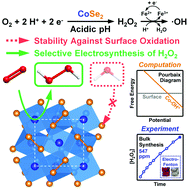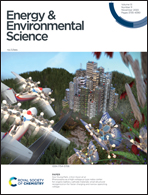Stable and selective electrosynthesis of hydrogen peroxide and the electro-Fenton process on CoSe2 polymorph catalysts†
Abstract
Electrochemical synthesis of hydrogen peroxide (H2O2) in acidic solution can enable the electro-Fenton process for decentralized environmental remediation, but robust and inexpensive electrocatalysts for the selective two-electron oxygen reduction reaction (2e− ORR) are lacking. Here, we present a joint computational/experimental study that shows both structural polymorphs of earth-abundant cobalt diselenide (orthorhombic o-CoSe2 and cubic c-CoSe2) are stable against surface oxidation and catalyst leaching due to the weak O* binding to Se sites, are highly active and selective for the 2e− ORR, and deliver higher kinetic current densities for H2O2 production than the state-of-the-art noble metal or single-atom catalysts in acidic solution. o-CoSe2 nanowires directly grown on carbon paper electrodes allow for the steady bulk electrosynthesis of H2O2 in 0.05 M H2SO4 with a practically useful accumulated concentration of 547 ppm, the highest among the reported 2e− ORR catalysts in acidic solution. Such efficient and stable H2O2 electrogeneration further enables the effective electro-Fenton process for model organic pollutant degradation.



 Please wait while we load your content...
Please wait while we load your content...
